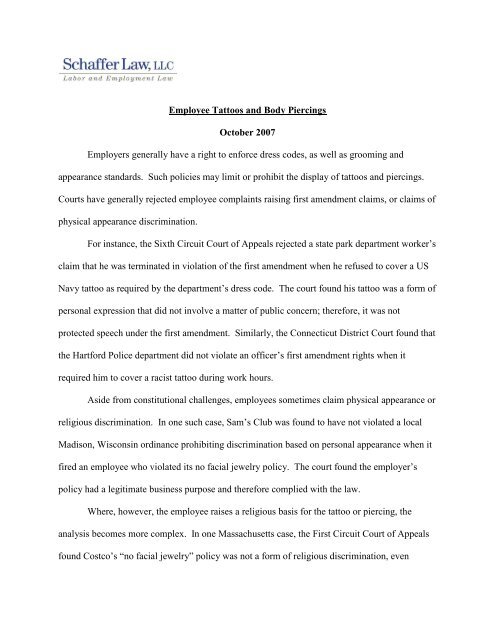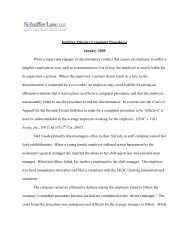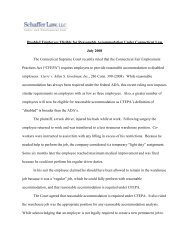Employee Tattoos and Body Piercings October 2007 Employers ...
Employee Tattoos and Body Piercings October 2007 Employers ...
Employee Tattoos and Body Piercings October 2007 Employers ...
You also want an ePaper? Increase the reach of your titles
YUMPU automatically turns print PDFs into web optimized ePapers that Google loves.
<strong>Employee</strong> <strong>Tattoos</strong> <strong>and</strong> <strong>Body</strong> <strong>Piercings</strong><br />
<strong>October</strong> <strong>2007</strong><br />
<strong>Employers</strong> generally have a right to enforce dress codes, as well as grooming <strong>and</strong><br />
appearance st<strong>and</strong>ards. Such policies may limit or prohibit the display of tattoos <strong>and</strong> piercings.<br />
Courts have generally rejected employee complaints raising first amendment claims, or claims of<br />
physical appearance discrimination.<br />
For instance, the Sixth Circuit Court of Appeals rejected a state park department worker’s<br />
claim that he was terminated in violation of the first amendment when he refused to cover a US<br />
Navy tattoo as required by the department’s dress code. The court found his tattoo was a form of<br />
personal expression that did not involve a matter of public concern; therefore, it was not<br />
protected speech under the first amendment. Similarly, the Connecticut District Court found that<br />
the Hartford Police department did not violate an officer’s first amendment rights when it<br />
required him to cover a racist tattoo during work hours.<br />
Aside from constitutional challenges, employees sometimes claim physical appearance or<br />
religious discrimination. In one such case, Sam’s Club was found to have not violated a local<br />
Madison, Wisconsin ordinance prohibiting discrimination based on personal appearance when it<br />
fired an employee who violated its no facial jewelry policy. The court found the employer’s<br />
policy had a legitimate business purpose <strong>and</strong> therefore complied with the law.<br />
Where, however, the employee raises a religious basis for the tattoo or piercing, the<br />
analysis becomes more complex. In one Massachusetts case, the First Circuit Court of Appeals<br />
found Costco’s “no facial jewelry” policy was not a form of religious discrimination, even
though the employee argued her membership in the Church of <strong>Body</strong> Modification required her to<br />
display facial jewelry at all times. The court found that requiring an exception to its rule would<br />
cause Costco an undue hardship in maintaining a particular public image.<br />
In contrast, a Washington state court found that Red Robin Restaurant may have violated<br />
Title VII’s prohibition on religious discrimination when it barred an employee from displaying a<br />
tiny wrist tattoo he received during a Kemet, or ancient Egyptian, religious ceremony. There the<br />
court, in denying the company’s motion for summary judgment, found there was a genuine<br />
question whether permitting the tattoo’s display would cause Red Robin an undue hardship.<br />
While employers may normally regulate the dress <strong>and</strong> appearance of employees, special<br />
care should be exercised when an employee claims a religious basis for their dress to ensure that<br />
reasonable accommodations are considered, <strong>and</strong> rejected only if they pose an undue hardship.<br />
For more information contact scott@schaffer-law.com or (860) 216-1965.<br />
www.schaffer-law.com<br />
2





